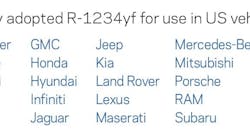Failed class-action suit asked for $300 million for plaintiffs in 29 states
An Illinois jury agreed that Allstate did not have to make up the value a claimant’s vehicle lost as a result of an accident. The $300 million diminished value class-action suit involved 387,000 plaintiffs from 29 states.
On April 29, a jury at the Circuit Court for the 20th Judicial District in St. Clair County, Belleville, Ill., agreed that Allstate does not owe policyholders for the diminished value of their damaged vehicles. The class-action suit, Sims vs. Allstate, evolved from a suit filed by an East St. Louis (located in St. Clair County), Ill., couple after their 1994 Toyota pickup truck was damaged in two separate accidents in 1996. Allstate paid Michael and Tiffany Sims nearly $3,000 for the repairs.
The couple later argued that they were entitled to the value they believed their vehicle lost due to its accident history. Their case eventually was certified as a class-action suit in December 2000 and included other Allstate policyholders with vehicles less than six years old and under 90,000 miles who incurred damages of at least $1,000 from June 1996 to February 2001. The trial began in April and lasted three weeks. The jury reached its decision after nearly four hours of deliberation.
While pleased with the ruling, Allstate contends the case had no merit. The insurer also criticizes the case venue, calling it inappropriate considering the significance and potential nationwide repercussions of the suit. “A local county court in Illinois shouldn’t be making law for policyholders in 29 states,” says Allstate spokesperson Mike Trevino. St. Clair County is located in southwest Illinois on the Missouri border and is part of the greater St. Louis metropolitan area.
As with other diminished value cases, arguments in Sims vs. Allstate centered on the interpretation of policy language. Specifically, jurors had to interpret the meaning of terms like loss, for example, Allstate’s promise to pay policyholders for direct and accidental loss to their vehicles. Judge Lloyd Cueto instructed the jury that they were to find against Allstate and in favor of the policyholders where such terms and policy language were not clear.
Lawyers for the plaintiffs argued that loss was just such an unclear term and could be interpreted to include diminished value. They based this argument on their contention that a vehicle could never be returned to pre-loss or pre-accident condition as the Allstate policy promised. Plaintiffs contended that even after a vehicle was repaired, damage remained to areas such as the paint and frame. That damage, plaintiffs claimed, reduced the value of the vehicle. Following the language of the policy and Allstate’s promise to pay for loss, the plaintiffs argued that the insurer was then responsible for covering this loss.
Allstate responded that the plaintiffs’ interpretation of loss was unreasonable and that policyholders accept the insurer’s definition of terms like loss when they sign a policy. Allstate used as an example consumers’ expectation when other products, such as televisions or lawnmowers, are repaired. In those cases, Allstate argued, consumers don’t expect to get either back in factory condition. Instead, they expect to have their products returned in functional condition. Those same expectations can be applied to automobile repair, Allstate argued.
To support this point, Allstate noted that its policy language regarding loss and repair has been in place since 1942, and since that time, the company always has acted in the same, well-known and uniform manner when handling claims. That manner does not include paying diminished value. Allstate also noted that the Simses had their vehicle repaired twice by Allstate and never asked for diminished value compensation.
In addition, the insurer pointed out that the Simses actually started their suit in 1999—fully two years after they ceased coverage with Allstate—and only after Tiffany Sims answered a newspaper ad placed by attorney Judy Cates, asking Allstate customers to be part of a class action diminished value case against the insurer.
Attorney H. Sinclair Kerr, representing Allstate, called the suit a creation of the plaintiffs’ lawyers, who were “looking for a huge payoff.” Cates stated that she would receive no money from a settlement.
Also at issue in the case was the manner in which Allstate would determine diminished value should the suit succeed. In October 2003, Allstate filed a motion to decertify the case, arguing that the plaintiffs had failed to produce a formula to determine inherent diminished value (IDV) for each vehicle that could be resolved at trial. Allstate contended that hundreds of thousands of vehicles would have to be individually analyzed to determine IDV, potentially resulting in thousands of “mini-trials.” Allstate asked the court to decertify the entire case or, if it declined to do that, to modify the case so that it only applied to Illinois where “all claims are governed by a clear set of jury instructions setting forth the same law for everyone.” The court did not grant the motion.
Sims vs. Allstate marked the latest in a series of setbacks for diminished value cases, following similar decisions in Miss., Mo., Del., Ohio, Ala., Ariz. and Texas. In a separate Illinois court ruling also in April, the First District Court of Appeals agreed with a lower court decision in the class action claim Martin vs. State Farm. Both courts ruled that State Farm did not have an oral agreement with its policyholders to cover diminished value. These losses don’t bode well for consumers involved in other diminished value cases.
Indeed, some observers believe the Sims vs. Allstate ruling might prove particularly damaging to the chances of future suits. Dan Risley, executive director of the Society of Collision Repair Specialists (SCRS), says, “Any time a court renders a decision involving a major insurance company, it has an impact on the rest of the industry. That impact can be both direct and indirect. In this particular case, it will have a negative impact on those insureds attempting to collect on claims of ‘diminished value’ in the future.”

